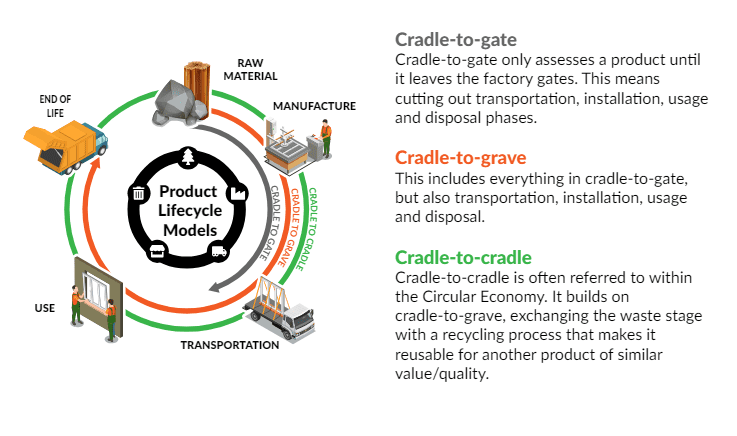Sustainability is increasingly important to consumers; members of the public are both more aware of the requirement for a circular economy and eager to do their bit to help the environment. However, the assessment of what constitutes a truly sustainable product is a complicated area of study and is only made harder by the greenwashing of unscrupulous firms to drive sales. Life Cycle Assessment (LCA) is a tool used to calculate the environmental impacts of a product over its entire lifecycle from raw material to end-of-life disposal. This tool provides data in numerous categories of potential environmental damage to give a complete picture and when done right, it is a powerful tool in clearing the “green fog”.
Why is LCA Important? It allows direct comparison of the environmental impact of the different product options.
The Stages of Life Cycle Assessment
There are five stages of Life Cycle Assessment and depending on which stages are included in the assessment, the name of the assessment varies. Cradle-to-gate assessments are the simplest to carry out, but the least useful in assessing the full impact of the product in question, as they can miss critical factors like inefficient operation or dangerous by-products in disposal. The cradle-to-grave assessment considers the full product cycle and gives a much more comprehensive and reliable impact appraisal. Cradle-to-cradle assessments go one step further in considering the reuse of the disposed materials in the production of further products and should be the long-term aim for all businesses.

Factors considered in LCA study
A Life Cycle Assessment will assess a product on a number of different factors. As the LCA standard is set to assess any product or material, the key factors will vary depending on the product type, but all factors should be assessed on any product to ensure that a rounded view of overall performance and sustainability is provided. The factors used to assess a product do not change between cradle-to-gate, cradle-to-grave and cradle-to-cradle assessments, although the impact of those factors may change. The factors are categorised and laid out below:

Given the current focus on climate change, Global Warming Potential is probably the key factor in most consumers’ decision-making, and while this is incredibly important, remember that it does not exist in a vacuum. Factors like Net Use of Fresh Water and Eutrophication Potential are becoming an increasingly immediate concern in preserving our natural watercourses and the associated habitat.
Assessment of Gowercroft Products and Benchmarking
Working with the University of Derby ERDF Low Carbon programme, Gowercroft Joinery carried out LCA testing on all of their main products utilising the Building Resource Establishment (BRE) online LINA tool. The output from this system is a detailed Environmental Product Declaration (EPD) document, which can then be benchmarked against other EPD documents available through BRE’s database. Dr. Walker from the University of Derby team identified and benchmarked EPDs for three different manufacturers utilising different window frame materials all for casement windows to provide some context for the Gowercroft results. The results below show those results against the results for our three ranges of casement windows. The comparison of EPDs can be very difficult for a number of reasons: each supplier measures inputs and outputs slightly differently; often the assessment is done for different window dimensions and (particularly with Aluminium and uPVC) the results are often modelled based on an unrealistically efficient manufacturing unit.
Global Warming Potential
Measured in Kilograms of CO2 Equivalent (kgCO2e); a balanced overview of contribution to climate change gases for a given product.

One of the key elements to note from the results is the significant difference between Cradle to Gate and Cradle to Grave results, with the long-term savings in application dwarfing the manufacture, delivery, and installation impact of the windows. The combination of highly energy-efficient products, extremely long service life, and limited maintenance requirements mean that these windows deliver massive Carbon Dioxide equivalent savings. This includes for allowances for regular glass replacement, scheduled maintenance visits and end-of-life recycling and biomass combustion. Unfortunately, benchmark results for Cradle to Grave were not available in the market, but Gowercroft products are uniquely long-life and low maintenance, so other manufacturers and particularly other materials are unlikely to come close. Further to this, the Gowercroft Heritage (Richmond) and Frontier (Acadia) window ranges are based around highly advanced vacuum units, which deliver an energy efficiency performance that dwarfs other products in the marketplace – this is why we see these products offering better lifetime Carbon Dioxide equivalent savings. For example, a competitor might offer a window with slim double glazing achieving a centre-pane U-value of 1.90W/(m2 K), these units have a lifespan which might be 5-10 years and the windows will require 5 yearly maintenance cycles; while our Richmond product achieves a centre-pane U-value of 0.48W/(m2•K), the units have a lifespan of 25 years and the windows will require 8-10 yearly maintenance cycles. This will translate to major differences in the Carbon Dioxide Equivalent results, as well as in other environmental factors.




What Next?
This assessment is not a final document, it represents a cross section of the products at the given time. Gowercroft will use these figures to continue to reduce, reuse and recycle throughout the business, as well as to identify areas where different sourcing might help to improve the results. The initial assessment is the start of a journey to redefine and improve a business to help achieve our sustainability ambitions.
Summary
The Hardwick, Richmond and Acadia products have displayed exceptional performance in all categories for Cradle to Grave use and would deliver high levels of life-long sustainability in either a new build or renovation project. While the products also perform better in most categories than the benchmarked alternate suppliers and materials in the Cradle to Gate comparison, it is the longevity of the product offering from Gowercroft and the high level of energy efficiency which stretch that advantage considerably over the Cradle to Grave comparison.
Award Winning Timber Windows and Doors
Gowercroft Joinery have been manufacturing and installing exceptional windows and doors for over 20 years. All design, manufacture, installation and aftercare in completed from our Derbyshire factory, which allows us to be highly responsive to your needs. Quality and product development are our passion. Our continual improvement culture means that we are always seeking ways to develop the product and processes to deliver consistency and unrivalled quality in the marketplace. This has led to the design of our three product ranges, which offer our unrivalled performance across a variety of project types.

